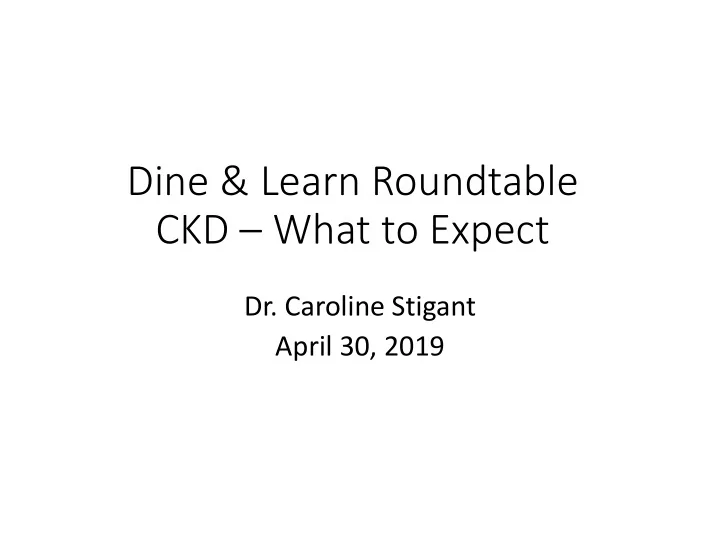

Dine & Learn Roundtable CKD – What to Expect Dr. Caroline Stigant April 30, 2019
4/25/2019 CHRONIC KIDNEY DISEASE - DEFINITION 1. Persistently* abnormal kidney function (ie. GFR < 60 mL/min) due to intrinsic disease of the kidney(s) or 2. Normal function (ie. GFR > 60), but persistent* structural or functional abnormality of the kidneys, with either - pathological abnormalities - markers of kidney damage (ie. proteinuria, hematuria) - kidney transplant examples: early PCKD, low-grade nephritis, well functioning kidney transplant * Persistent = >3 months ‘CGA’ of Kidney Disease Screening Cause, GFR, and Albuminuria all required for assessing risk of complications and future outcomes Green: low risk; Yellow: moderately increased risk; Orange: high risk; Red: very high risk 1
4/25/2019 COMMON CAUSES OF THE SYNDROME OF CKD • Hypertension • Diabetes 99% of the diagnoses, - most often normal urinalysis • Ischemic / vascular - usually low-grade albuminuria (except DM) • Glomerular disease • PCKD • Drug-Induced • Pyelonephritis • Reflux GFR DECLINES WITH AGE (Average – 1 to 2 mL/min/year) 2
4/25/2019 NEPHRONS ARE LOST WITH AGING, PROPORTIONAL TO GFR DECLINE The Substantial Loss of Nephrons in Healthy Human Kidneys with Aging Denic A et al. JASN 2017;28 Normal kidney 3
4/25/2019 Nephrosclerosis NATURAL HISTORY OF CKD • Results vary between studies and according to diagnosis, in general: • Non-proteinuric disease / general population: -1 mL/min GFR per year • Diabetes (untreated): -5-10 mL/min/yr • Diabetes (treated): 1-5 mL/min/yr\ • Non-diabetic proteinuria: up to 10+ mL/min/yr • Often a different syndrome • Nephritic (hematuria, proteinuria, edema, hypertension) • Nephrotic (albuminuria 3+ grams daily, hypoalbuminemia, edema, hypercholesterolemia) • ‘RPGN’ – Rapidly progressive glomerulonephritis – active urine sediment with marked loss of kidney function over weeks to months 4
4/25/2019 WHAT TO DO IF ABNORMAL RESULT • For patients with a new finding of an eGFR < 60 mL/min or urine abnormality, determine stability of patient’s kidney status by: • Repeating within week(s), • and then in 3-6 months • ALWAYS GET URINALYSIS AND URINE ACR • Is this ‘just’ a hemodynamic change or is this a different renal syndrome • Except if severely abnormal (GFR < 30) • Assess, repeat sooner, &/or involve nephrologist • ONE MEASUREMENT IS NOT ENOUGH PLEASE ALWAYS ALWAYS ALWAYS CONSIDER REVERSIBLE FACTORS • Intercurrent illness • Volume depletion • Medications • NSAIDs, aminoglycosides, IV contrast dye, diuretics • Obstruction • Remember: small fluctuations are common and not indicative of progression 5
4/25/2019 Identify patients in your practice at high risk for Chronic Kidney Disease - Patients with hypertension - Patients with heart failure - Patients with diabetes mellitus - Patients with unexplained anemia - Patients with atherosclerotic coronary, - Patients with a family history of end stage renal disease cerebral or peripheral vascular disease - High risk ethnicity eGFR 30-60 eGFR >60 eGFR <30 Consider reversible factors: Individualized follow up -Medication - Volume depletion and treatment -Intercurrent illness - Obstruction CKD is diagnosed in this group only if other renal abnormalities are present Repeat tests (usually in 2 - 4 weeks) (i.e. proteinuria, hematuria, anatomical) eGFR <30 eGFR 30-60 Nephrology referral Follow eGFR at 3 months then serially recommended Assess for persistent significant proteinuria Implement risk reduction eGFR < 30 Stable eGFR 30-60 or progressive decline in eGFR and or persistent significant proteinuria no significant proteinuria or inability to attain treatment targets Impact of Lifestyle Therapies on Blood Pressure in Hypertensive Adults Intervention Intervention SBP/DBP -1800 mg/day* sodium Reduce foods with -5.1 / -2.7 added sodium Hypertensive Weight loss -1.1 / -0.9 -1 kg -3.9 / -2.4 Alcohol intake -3.6 drinks/day Aerobic exercise -4.9 / -3.7 120-150 min/week DASH diet Dietary patterns Hypertensive -11.4 / -5.5 Normotensive -3.6 / -1.8 Applying the 2005 Canadian Hypertension Education Program recommendations: 3. Lifestyle modifications to prevent and treat * 2,300 mg sodium = 1 level teaspoon of table salt hypertension Padwal R. et al. CMAJ ・ SEPT. 27, 2005; 173 (7) 749-751 6
4/25/2019 KIDNEY DISEASE MANAGEMENT: NON-SPECIFIC TREATMENTS • BP control • Target < 140/90 non-diabetic CKD, < 130/80 diabetic CKD • ACE inhibitor &/or Angiotensin receptor blocker usual 1 st line agent, especially if albuminuria present • Glycemic control if diabetic • Dietary protein restriction • Dietary sodium restriction • General lifestyle: weight reduction, exercise, smoking cessation, vaccinations (influenza, pneumovax, +/- Hepatitis B) • Other: • Acidosis correction (NaHCO 3 ) • ? Statin therapy • ? Uric acid lowering therapy • INFORM PATIENTS of their GFR & activate them with self-care (ie. BP monitoring, diet changes, tracking lab data) 7
Recommend
More recommend